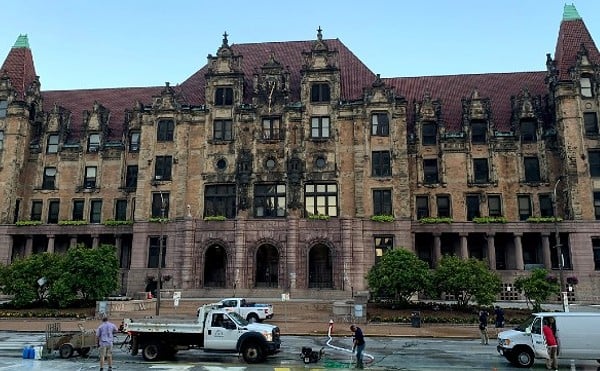But Gulliver is slain now, and the forlorn neighbors who were witness have just begun to make sense of it.
They're people like Nance and Skip Smith, like Sandy King, like Paris Bouchard, people who don't just sit and try to make sense of things, people who get up and fix things that don't make sense. They're people who, behind a cadre of active neighborhood associations, have visibly transformed their streets in the last four years: the dog park just off the cul-de-sac between Maryland and Boyle avenues to the rehabbed once-derelict buildings; the use of the city's nuisance ordinance to shut down a suspected drug house; the gardens, the red maples, the cobblestones, the litter-free sidewalks. It's no surprise that property values in the area surrounding 4373 W. Pine are upward bound -- existing homes have, in many cases, doubled in value in the last five years.
But in the end, these neighbors so concerned about results could do nothing about their Winkelmeyer house. "It was like our Alamo or whatever," sighs Nance Smith. "It was the last standing something to try to save, because now that side of the street might be totally knocked out."
And so, understand, when granddaddy-turned-trespasser Tanurchis stole inside the Winkelmeyer house earlier this month (he didn't advance more than a dozen feet past the door), he technically broke the law not so much as an act of protest as an attempt to pay respects to a piece of history that would soon be reduced to salvageable brick and unwanted rubble ... and wonder how, how does a community so inspired lose a battle so monumental on its own turf?
"It's just a shame," Tanurchis says, "that they did not try to work out a compromise with the neighborhood, that they don't care about the neighborhood. They aren't here day to day. If you don't have people like Nance and Skip and Sandy, walking and doing a lot of work in the neighborhood, what kind of neighborhood would it be? What kind of neighborhood would it be if you didn't have people like us that wanted to make it better and better and better? It's just a shame to see that piece of our history torn down."
Before Ronald McDonald House closed on the Winkelmeyer house on April 25 last year, the Romanesque revival building was a nursing home owned by Hendricks Consulting. Though the original roof and the third floor had been missing since the middle of the last century, the home, designed by Otto Wilhelmi (an architect of Compton Heights repute) did boast a 19th-century carriage house in the rear. The interior, according to the city's Cultural Resources Office, was remarkably intact, complete with a wooden beam staircase (painted over) and original windows. Ronald McDonald representatives, however, note that the poor condition of the building -- the lost third floor, the water-damaged walls, the cracked brick (much of the deterioration, say neighbors who toured the home before the Ronald McDonald purchase, occurred after the charity completed the sale) -- justified demolition.
The charity estimated that for $54,000 less than the cost of a complete rehab (the estimate was derived from their least-costly rehab scenario), the home could be demolished and a contemporary structure built, gaining in the process two additional units and five additional parking spaces, as well as optimum usage of square footage. Specifically, permission for demolition -- of the Winkelmeyer house, its carriage house and a 1960 one-story structure on the property -- permits the charity to move forward with a $1.6 million expansion. The expansion would provide contiguous eight-unit apartment-style dwellings and 23 new parking spaces for families of seriously ill children. The demolition would also leave space for a second phase of expansion, which would provide the charity with an additional eight units.
And so the interest in saving money outweighed the interests of neighborhoods filled with residents relying only on grassroots activism. Why, in grassroots terms, these neighborhoods had everything, didn't they? The support of their alderman -- albeit an alderman who was admittedly hesitant to engage in tooth-and-nail combat with a charity he respected. An established trend toward single-family homes. An ongoing Landmarks Association of St. Louis evaluation for historic-district status. Untiring activists who had immediately sought the Cultural Resources Office's help in guiding them through the tedious process of protecting their history and gotten in touch with the Ronald McDonald House to convey their opposition to demolition even before the charity bought the property. Intelligent, well-articulated alternatives to demolition were offered, ranging from building on vacant lots and using existing apartments to a renovation-demolition combination that would save the Winkelmeyer house but knock down the architecturally insignificant structure sharing the property. The West Pine/Laclede Neighborhood Association voted 62-2 against demolition. Dan Harbaugh, director of Ronald McDonald House, doesn't trust the vote and believes the opposition is confined to a small, vocal minority of residents. The expansion is needed to cater to families of ill children, he adds.
In October, though, that expansion was denied when Cultural Resources Office director Kathleen Shea ruled against demolition. And in February, after a Ronald McDonald appeal spurred a city Preservation Board hearing, came an overwhelming 7-0 vote by the board, again against demolition. It seemed activism had won out.
But the neighborhood that had everything couldn't stop a second appeal by Ronald McDonald to the St. Louis Planning Commission, which on April 11 abruptly overturned the unanimous Preservation Board decision with its own 7-4 vote favoring demolition. The reversal stunned the preservationists.
"I had been in contact with Cultural Resources numerous times to say, 'OK, walk me through this,'" explains West Pine/Laclede Neighborhood Association secretary Sandy King. "'If you do vote to deny them a demolition permit, then what is the next step?' Up until a week before I heard about this Planning Commission, they were, like, 'Well, they'll have to go to circuit court.' And then we're blindsided, and all of a sudden there's this Planning Commission. And we're, like, 'What is this? Nobody told us this.'"
Ald. Fred Wessels (D-13th Ward) was part of the Planning Commission contingent that reversed the Preservation Board's decision in April. He says, "The Preservation Board blew it. I didn't think the building in question deserved to be preserved. No question in my mind. There were some neighborhood activists interested in keeping it. I think the Preservation Board listened to those activists and didn't listen to the facts of the case." Wessels disagrees with several of the Preservation Board's conclusions, including the assertion that demolition of the Winkelmeyer house would hurt a West Pine block face composed of well-maintained historic buildings. He says one brick building across the street had been painted and two others (the Independence Center, 4380 W. Pine) were "connected by a very ugly façade.
"So the two buildings directly across the street were in direct contradiction to the Preservation Board's conclusion that the block face was composed of well-maintained historic buildings," says Wessels. "You don't paint historic buildings gray." ("Now, Fred's a friend of mine and everything, but I'm going to disagree with him on that," the neighborhood's alderman, Joe Roddy [D-17th] says later.)
"If I had the right to talk [at the Planning Commission hearing], I would have said, 'Fred Wessels, who gives you the right to call our block ugly?'" Tanurchis retorts testily. "This is not about ugly. This is about saving a home that Ronald McDonald has right next to it. Let's don't worry about the building across the street. We're talking about this building. Don't worry about Independence Center and what kind of glass façade they got. We're not here for Independence Center. We're here for Ronald McDonald. You don't knock people's neighborhood. If I want to knock it, I live here -- let me knock it. But not some outsider who comes into our neighborhood and knocks our neighborhood."
But even Shea, who spoke against demolition before the Planning Commission, is loath to criticize the vote, as are most members of the Preservation Board itself. "I thought the process worked," Shea says. "I advocated for it to be saved on the record ... I mean, of course, we just set this up so there was a broader review of these activities, and decisions were made in the context of a bigger plan than just each individual issue being picked off randomly. So, in that sense, it was good to see the process work."
More than 18 months ago, a much-touted reorganization of the development arm of city government by then-Mayor Clarence Harmon produced, among other changes, the "process" that resulted in the Winkelmeyer house's destruction. Before reorganization, demolition requests were channeled to the Heritage and Urban Design Commission, appealed to the commission's board and, if denied again, appealed in Circuit Court. Reorganization replaced HUDC with the ostensibly more focused Cultural Resources Office and its appeals body, the Preservation Board. Inserting a second bureaucratic appeal into the demolitions process (to the Planning Commission) meant that the city's preservation authority was now on a leash. Now, the final say on CRO demolition requests rests with an agency whose sole purpose is not to preserve and protect the city's historic character but to see that all areas of the city adhere to long-term development plans. (Paul Beckerle, the former alderman who sponsored the reorganization ordinances, did not return repeated calls.)
Not everyone was happy with the reorganization. Preservation architect Jeff Brambila, after an 11-year tenure with HUDC, declined to serve on the new Preservation Board. Instead, he opted -- unsuccessfully -- to throw his hat into the ring for a spot on the Planning Commission. "I didn't feel like I wanted to step down, so to speak, to a lesser board," he says.
Under reorganization, the Preservation Board would consider changes in historic districts and other designated areas but, unlike its predecessor, would not rule on demolitions citywide. The board's tightened scope, according to Shea, who was also commissioner of HUDC, would make for a more focused and therefore more effective preservation body. "The Heritage Commission was never popular," Shea says. "No one understood what they did at the time ... because, I think, no one understood the context in which they made decisions."
Brambila, meanwhile, agrees only that HUDC was disliked. "Perhaps the underlying problem was that the Heritage Commission, for many, many years, was not very popular among quite a number of aldermen, simply because they were getting complaints from constituents when they weren't allowed to do things, and I felt, politically, it was not a favorite of a lot of people," he says. "I think an idea of reorganization was perhaps to diminish some of the commission's powers."
And so the demise of the Winkelmeyer house serves, perhaps, as the first real opportunity to measure the strength of the city's attitude toward preservation after the 1999 reorganization.
"It just seemed like all the people who were closest to the decision were kind of overruled and ignored in this, and that's contrary to how most of the city boards run," says Roddy. "As an alderman, I've always tried to empower those folks impacted by those types of decisions, and I was disappointed to see that in this case the city didn't support those groups."
But is the Planning Commission vote a reflection of a weak preservation authority, as preservationists contend, or merely a part of a process that works? "This is just tawdry," groans Lana Stein, a political-science professor at the University of Missouri-St. Louis. "This is just really tawdry. There is that reversal authority. When they changed from Heritage to this, I believe that their authority was lessened -- noticeably. Reorganization was to make development easier in the city. But you pay a price with that."
Wessels thinks otherwise. "It's called due process," he explains. "It's a free country, and there are appeals in any system, and after the city boards are finished ... then people are free to go to circuit court."
But it's a due process that has even a member of the Preservation Board feeling betrayed. "People figure, 'Am I wasting my time?'" confides the only member of the Cultural Resources appeals board who would consent to an interview. "It just seems to be one more level of bureaucracy that doesn't need to be there. 'What is this about?' you wonder."
"I mean, that's the real story -- the decision-making process," adds Landmarks Association board member Bill Seibert. "In terms of an abusive administrative power and authority, that was an unbelievable case, and that has to change. Preservationists are very worried. I do know that from what was proposed to what the Board of Aldermen finally spit out at the other end was complete sort of turning on its head what had been hoped for. And we had felt that there was really an effort to essentially emasculate the power of the Preservation Board."
As for those neighbors who desperately fought for any resolution that would not destroy the century-old Winkelmeyer house and its ancillary carriage house, the Planning Commission's reversal served only to smudge any perception of a responsive city government.
"When you do something like this, it strips the empowerment of the neighborhood," reflects Paris Bouchard of the abutting Maryland/Boyle neighborhood group. "If a group feels a certain decision is what's best for them, I think that should be held with a lot of respect. You always hear about government trying to empower the neighborhood, to develop plans, to develop this and that, but if they're not followed, well, what point is having those plans and what point is empowering those people if they're not going to be involved in the decision process?"





